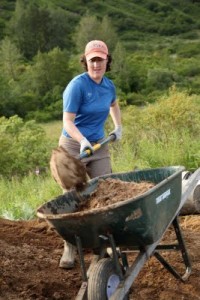(Click sentence to hear Alutiiq words spoken.)
Digging tools were important in classical Alutiiq society, both for subsistence activities and for construction. Men and women used long, pointed pieces of whalebone to dig clams from the beach and unearth the roots of plants used for food and medicine.
Alutiiqs also fashioned shovels from wood and bone. Artifacts from the Uyak site in Larsen Bay illustrate that craftsmen shaped the scapulas of sea mammals and bears into shovel blades. These broad shoulder bones were drilled at the narrow end so a handle could be attached. Then the wide end of the bone was shaped and tapered to create the digging blade. Similar shovel blades are found in archaeological sites in western Alaska, illustrating the widespread use of this tool.
The use of bone shovels must be thousands of years old, because Alutiiq people built their houses by digging large foundation holes as early as 4,500 years ago. These early sunken floors were up to three feet deep and thirteen feet across, requiring builders to remove large amounts of earth during construction.
The Alutiiq word lapaat’kaaq comes directly from the Russian term for shovel, lopaatka, and illustrates how words from other languages have been absorbed into Alutiiq by simply adding an Alutiiq suffix.

